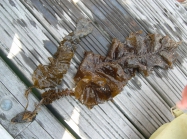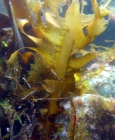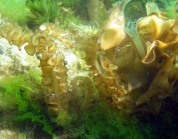
| Intro | | Search taxa | | Browse taxa | | Distributions | | Terminology | | References | | Statistics | | Online sources | | Tutorial | | Log in |
WRiMS taxon detailsUndaria pinnatifida (Harvey) Suringar, 1873
145721 (urn:lsid:marinespecies.org:taxname:145721)
accepted
Species
marine
(of ) Harvey, W. H. (1860). Characters of new algae, chiefly from Japan and adjacent regions, collected by Charles Wright in the North Pacific Exploring Expedition under Captain James Rodgers. <em>Proceedings of the American Academy of Arts and Sciences.</em> 4: 327-335.
page(s): 329 [details]
Guiry, M.D. & Guiry, G.M. (2021). AlgaeBase. World-wide electronic publication, National University of Ireland, Galway (taxonomic information republished from AlgaeBase with permission of M.D. Guiry). Undaria pinnatifida (Harvey) Suringar, 1873. Accessed through: Ahyong, S.; Costello, M. J.; Galil, B. S.; Gollasch, S.; Hutchings, P.; Katsanevakis, S.; Lejeusne, C.; Marchini, A.; Occhipinti, A.; Pagad, S.; Poore, G. C. B; Rius, M.; Robinson, T. B.; Sterrer, W.; Turon, X.; Willan, R. C.; Zhan, A. (2021) World Register of Introduced Marine Species (WRiMS) at: http://www.marinespecies.org/introduced/aphia.php?p=taxdetails&id=145721 on 2024-04-16
Costello, M. J.; Ahyong, S.; Bieler, R.; Boudouresque, C.; Desiderato, A.; Downey, R.; Galil, B. S.; Gollasch, S.; Hutchings, P.; Kamburska, L.; Katsanevakis, S.; Kupriyanova, E.; Lejeusne, C.; Ma, K. C. K.; Marchini, A.; Occhipinti, A.; Pagad, S.; Panov, V. E.; Poore, G. C. B.; Rewicz, T.; Robinson, T. B.; Rius, M.; Sobczyk, R.; Stern, N.; Turon, X.; Valls Domedel, G.; Verleye, T.; Vieira, L. M.; Willan, R. C.; Yeo Chong Jinn, D.; Zhan, A. (2024). World Register of Introduced Marine Species (WRiMS). Undaria pinnatifida (Harvey) Suringar, 1873. Accessed at: https://marinespecies.org/introduced/aphia.php?p=taxdetails&id=145721 on 2024-04-16
Date action by
original description
(of ) Harvey, W. H. (1860). Characters of new algae, chiefly from Japan and adjacent regions, collected by Charles Wright in the North Pacific Exploring Expedition under Captain James Rodgers. <em>Proceedings of the American Academy of Arts and Sciences.</em> 4: 327-335.
page(s): 329 [details] context source (Introduced species) Katsanevakis, S.; Bogucarskis, K.; Gatto, F.; Vandekerkhove, J.; Deriu, I.; Cardoso A.S. (2012). Building the European Alien Species Information Network (EASIN): a novel approach for the exploration of distributed alien species data. <em>BioInvasions Records.</em> 1: 235-245., available online at http://easin.jrc.ec.europa.eu [details] Available for editors context source (Schelde) (2010). Bedreiging voor biodiversiteit. Indicatoren voor het Schelde-estuarium. <em>Opgemaakt in opdracht van Afdeling Maritieme Toegang, projectgroep EcoWaMorSe, Vlaams Nederlandse Scheldecommissie. VLIZ Information Sheets, 200. Vlaams Instituut voor de Zee (VLIZ): Oostende.</em> 7 pp. (look up in IMIS) [details] basis of record Guiry, M.D. (2001). Macroalgae of Rhodophycota, Phaeophycota, Chlorophycota, and two genera of Xanthophycota, <B><I>in</I></B>: Costello, M.J. <i>et al.</i> (Ed.) (2001). <i>European register of marine species: a check-list of the marine species in Europe and a bibliography of guides to their identification. Collection Patrimoines Naturels,</i> 50: pp. 20-38 (look up in IMIS) [details] additional source Muller, Y. (2004). Faune et flore du littoral du Nord, du Pas-de-Calais et de la Belgique: inventaire. [Coastal fauna and flora of the Nord, Pas-de-Calais and Belgium: inventory]. <em>Commission Régionale de Biologie Région Nord Pas-de-Calais: France.</em> 307 pp., available online at http://www.vliz.be/imisdocs/publications/145561.pdf [details] additional source Streftaris, N., A. Zenetos & E. Papathanassiou. (2005). Globalisation in marine ecosystems: the story of non-indigenous marine species across European seas. <em>Oceanogry and Marine Biology: an Annual Review.</em> 43: 419-453. (look up in IMIS) [details] Available for editors additional source Zenetos, A.; Çinar, M.E.; Pancucci-Papadopoulou, M.A.; Harmelin, J.-G.; Furnari, G.; Andaloro, F.; Bellou, N.; Streftaris, N.; Zibrowius, H. (2005). Annotated list of marine alien species in the Mediterranean with records of the worst invasive species. <em>Mediterranean Marine Science.</em> 6 (2): 63-118., available online at https://www.researchgate.net/publication/273213810_Annotated_list_of_marine_alien_species_in_the_Mediterranean_with_records_of_the_worst_invasive_species [details] Available for editors additional source Occhipinti-Ambrogi, A., A. Marchini, G. Cantone, A. Castelli, C. Chimenz, M. Cormaci, C. Froglia, G. Furnari, M.C. Gambi, G. Giaccone, A. Giangrande, C. Gravil, F. Mastrototaro, C. Mazziotti, L. Orsi-Relini & S. Piraino. (2010). Alien species along the Italian coasts: an overview. <em>Biological Invasions.</em> 13(1): 215-237., available online at https://doi.org/10.1007/s10530-010-9803-y [details] Available for editors additional source Liu, J.Y. [Ruiyu] (ed.). (2008). Checklist of marine biota of China seas. <em>China Science Press.</em> 1267 pp. (look up in IMIS) [details] Available for editors additional source Zenetos, A.; Gofas, S.; Verlaque, M.; Cinar, M.; Garcia Raso, J.; Bianchi, C.; Morri, C.; Azzurro, E.; Bilecenoglu, M.; Froglia, C.; Siokou, I.; Violanti, D.; Sfriso, A.; San Martin, G.; Giangrande, A.; Katagan, T.; Ballesteros, E.; Ramos-Espla, A.; Mastrototaro, F.; Ocana, O.; Zingone, A.; Gambi, M.; Streftaris, N. (2010). Alien species in the Mediterranean Sea by 2010. A contribution to the application of European Union's Marine Strategy Framework Directive (MSFD). Part I. Spatial distribution. <em>Mediterranean Marine Science.</em> 11(2): 381-493., available online at https://doi.org/10.12681/mms.87 [details] additional source Broady, P.A.; Flint, E.A.; Nelson, W.A.; Cassie Cooper, V.; De Winton, M.D.; Novis, P.M. (2012). Phylum Chlorophyta and Charophyta: green algae, in: Gordon, D.P. (Ed.) (2012). New Zealand inventory of biodiversity: 3. Kingdoms Bacteria, Protozoa, Chromista, Plantae, Fungi. pp. 347-381. [details] additional source Eno, N. C.; Clark, R. A.; Sanderson, W. G. (1997). Non-native marine species in British waters: a review and directory. <em>Joint Nature Conservation Committee, Peterborough.</em> pp. 136. (look up in IMIS) [details] Available for editors additional source Lutaenko, K.A.; Furota, T.; Nakayama; S.; Shin, K.; Xu, J. (2013). Atlas of Marine Invasive Species in the NOWPAP Region. Beijing: NOWPAP DINRAC (Northwest Pacific Action Plan, Data and Information Network Regional Center). 189 pp. [details] additional source Marchini, A., J. Ferrario, A. Sfriso & A. Occhipinti-Ambrogi. (2015). Current status and trends of biological invasions in the Lagoon of Venice, a hotspot of marine NIS introductions in the Mediterranean Sea. <em>Biological Invasions.</em> 17:2943–2962., available online at https://doi.org/10.1007/s10530-015-0922-3 [details] Available for editors additional source Verlaque, M.; Ruitton, S.; Mineur, F.; Boudouresque, C.-F. (2007). CIESM Atlas of Exotic Macrophytes in the Mediterranean Sea. <em>Rapport de la Commission de l'Exploration de la mer Méditerranée, Monaco.</em> 38., available online at http://www.ciesm.org/atlas/appendix4.html#top [details] Available for editors additional source Mollo, E.; Cimino, G.; Ghiselin, M. T. (2014). Alien biomolecules: a new challenge for natural product chemists. <em>Biological Invasions.</em> 17(3): 941-950., available online at https://doi.org/10.1007/s10530-014-0835-6 note: We show how a kind of chemical data originally gathered for other objectives—such as obtaining drugs from the sea—might also offer valid alternatives to unrealistic eradication campaigns, becoming... We show how a kind of chemical data originally gathered for other objectives—such as obtaining drugs from the sea—might also offer valid alternatives to unrealistic eradication campaigns, becoming the basis for a desirable commercial use of the bioactive compounds obtainable from marine pests, thus paving the way for making the control of invasions profitable. The pests might then be harvested, reducing their impact on marine ecosystems. additional source Guiry, M.D. & Guiry, G.M. (2023). AlgaeBase. <em>World-wide electronic publication, National University of Ireland, Galway.</em> searched on YYYY-MM-DD., available online at http://www.algaebase.org [details] status source Lin, Y.; Gao, Z.; Zhan, A. (2015). Introduction and use of non-native species for aquaculture in China: status, risks and management solutions. <em>Reviews in Aquaculture.</em> 7(1): 28-58., available online at https://doi.org/10.1111/raq.12052 [details]  Present Present  Inaccurate Inaccurate  Introduced: alien Introduced: alien  Containing type locality Containing type locality
From regional or thematic species database
Introduced species abundance United Kingdom part of the English Channel (Marine Region) Dominant [details]Introduced species abundance Argentinean part of the South Atlantic Ocean (Marine Region): Rare [details] Introduced species impact Argentinean part of the South Atlantic Ocean (Marine Region): Other impact - undefined or uncertain [details] Introduced species impact Australian part of the Tasman Sea (Marine Region) : Other impact - undefined or uncertain [details] Introduced species impact in Belgian part of the North Sea : Other impact - undefined or uncertain [details] Introduced species impact in United Kingdom part of the North Sea (Marine Region) : Water abstraction or nuisance fouling [details] Introduced species impact in United Kingdom (Nation) : Other impact - undefined or uncertain [details] Introduced species impact in French part of the English Channel (Marine Region) : Other impact - undefined or uncertain [details] Introduced species impact in Australian part of the Tasman Sea (Marine Region) : Loss of aquaculture/commercial/recreational harvest or gain [details] Introduced species impact in Australian part of the Tasman Sea (Marine Region) : Outcompetes native species for resources and/or space [details] Introduced species impact in Australian part of the Tasman Sea (Marine Region) : Water abstraction or nuisance fouling [details] Introduced species impact Chinese part of the Eastern Chinese Sea(Marine Region) Adverse habitat modification [details] Introduced species impact Chinese part of the Yellow Sea (Marine Region) Adverse habitat modification [details] Introduced species impact United Kingdom part of the English Channel (Marine Region) Other impact - undefined or uncertain Our results suggest that a shift towards U. pinnatifida dominated reefs could result in impoverished epibiotic assemblages and lower local biodiversity [details] Introduced species remark In Australia (Nation) : Concern recorded: Considering this species has a high capacity to colonise new substrata and to grow rapidly, major changes might be expected in Mar del Plata benthic community. [details] Introduced species vector dispersal Argentinean part of the South Atlantic Ocean (Marine Region) Ships: general [details] Introduced species vector dispersal in Belgian part of the North Sea: Aquaculture: accidental [details] Introduced species vector dispersal Argentinean part of the South Atlantic Ocean (Marine Region) Ships: accidental as attached or free-living fouling organisms [details] Introduced species vector dispersal United Kingdom part of the English Channel (Marine Region) Ships: general [details] Introduced species vector dispersal in Australian part of the Tasman Sea (Marine Region) : Fisheries: accidental with deliberate translocations of fish or shellfish [details] Introduced species vector dispersal in United Kingdom part of the North Sea (Marine Region) : Ships: general [details] Introduced species vector dispersal Argentinean part of the South Atlantic Ocean (Marine Region): Boat hull fouling cannot be ruled out as an introduction vector. However cultivation trials with this species have been carried out in the Lastres inlet and is only a few hundred metres away from the discovery site suggesting farming of the sp. as the mos [details] Introduced species vector dispersal Argentinean part of the South Atlantic Ocean (Marine Region): Scientific research: accidental release with research activities [details] Introduced species vector dispersal in United Kingdom (Nation) : Fisheries: accidental with deliberate translocations of fish or shellfish [details] Introduced species vector dispersal in United Kingdom (Nation) : Spread across the Galician coast and the Cantabrian coast due to aquaculture activities and possibly hull fouling from pleasure craft. [details] Introduced species vector dispersal in French part of the English Channel (Marine Region) : Recreational vessels believed to be main mechanism of introduction to SF Bay [details] Introduced species vector dispersal in French part of the English Channel (Marine Region) : Ships: accidental as attached or free-living fouling organisms [details] Introduced species vector dispersal in France (Nation) : Fisheries: accidental with deliberate translocations of fish or shellfish [details] Introduced species vector dispersal in France (Nation) : Fisheries: deliberate translocations of fish or shellfish to establish or support fishery [details] Introduced species vector dispersal in France (Nation) : Shipping [details] Introduced species vector dispersal in Australia (Nation) : Natural dispersal The introductory vector is still unknown, butsimple drift arrival is unlikely because the nearest Undaria population is located 1300 km to the south. [details] Introduced species vector dispersal Argentinean part of the South Atlantic Ocean (Marine Region) Natural dispersal [details] Introduced species vector dispersal Uruguayan part of the South Atlantic Ocean (Marine Region) Natural dispersal [details] Introduced species vector dispersal Uruguayan part of the South Atlantic Ocean (Marine Region) Ships: general [details] Introduced species vector dispersal in Belgian part of the North Sea: Ships: accidental as attached or free-living fouling organisms [details] Introduced species vector dispersal Chinese part of the Yellow Sea (Marine Region) Aquaculture [details] Introduced species vector dispersal Chinese part of the Eastern Chinese Sea(Marine Region) Aquaculture [details]
Global invasive species database - Undaria pinnatifida
Marine Life Information Network - UK Published in AlgaeBase  To Barcode of Life (10 barcodes) To Biodiversity Heritage Library (41 publications) To European Nucleotide Archive (ENA) To GenBank (57629 nucleotides; 1397 proteins) To Global Invasive Species Database (GISD) To Information system on Aquatic Non-Indigenous and Cryptogenic Species (AquaNIS) To Niet-inheemse soorten Belgisch deel Noordzee en aanpalende estuaria (in Dutch) To PESI |


